2011_罗宾斯_管理学_11版_英文PPT_09
罗宾斯管理学第11版
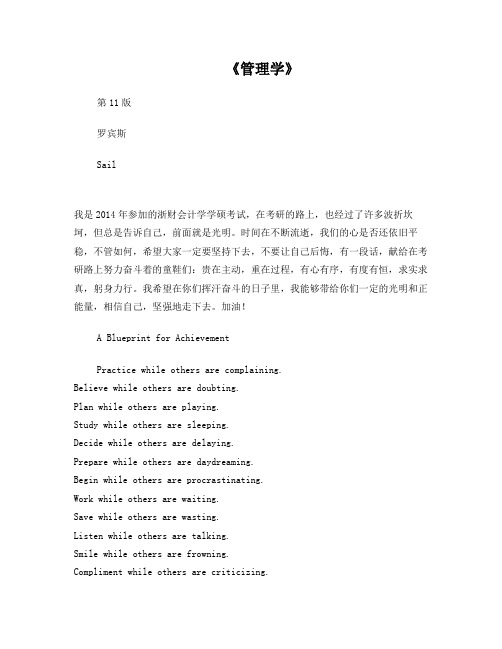
《管理学》第11版罗宾斯Sail我是2014年参加的浙财会计学学硕考试,在考研的路上,也经过了许多波折坎坷,但总是告诉自己,前面就是光明。
时间在不断流逝,我们的心是否还依旧平稳,不管如何,希望大家一定要坚持下去,不要让自己后悔,有一段话,献给在考研路上努力奋斗着的童鞋们:贵在主动,重在过程,有心有序,有度有恒,求实求真,躬身力行。
我希望在你们挥汗奋斗的日子里,我能够带给你们一定的光明和正能量,相信自己,坚强地走下去。
加油!A Blueprint for AchievementPractice while others are complaining.Believe while others are doubting.Plan while others are playing.Study while others are sleeping.Decide while others are delaying.Prepare while others are daydreaming.Begin while others are procrastinating.Work while others are waiting.Save while others are wasting.Listen while others are talking.Smile while others are frowning.Compliment while others are criticizing.Persist while others are quitting.Progress while others are lagging behind.Then, you will succeed while others are failing.目录第一篇管理导论 2第1章管理与组织领导 21.1管理者为什么对组织很重要? 21.2谁是管理者以及他们在那里工作? 21.3管理者的职能、角色和技能。
管理学罗宾斯第11版
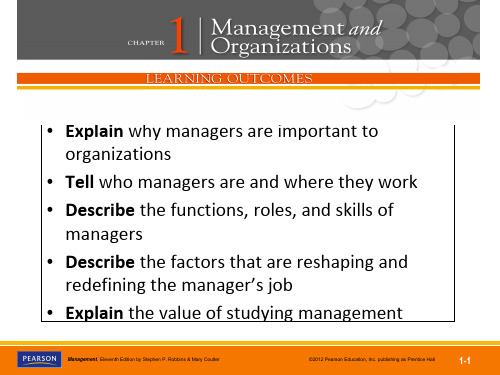
– Have a distinct purpose (goal) – Are composed of people – Have a deliberate structure
Management, Eleventh Edition by Stephen P. Robbins & Mary Coulter
• Explain why managers are important to organizations
• Tell who managers are and where they work
• Describe the functions, roles, and skills of managers
©2012 Pearson Education, Inc. publishing as Prentice Hall
1-14
Exhibit 1-5: Mintzberg’s Managerial Roles
Management, Eleventh Edition by Stephen P. Robbins & Mary Coulter
©2012 Pearson Education, Inc. publishing as Prentice Hall
1-7
What Do Managers Do?
• Management involves coordinating and overseeing the work activities of others so that their activities are completed efficiently and effectively.
罗宾斯管理学英文版课件
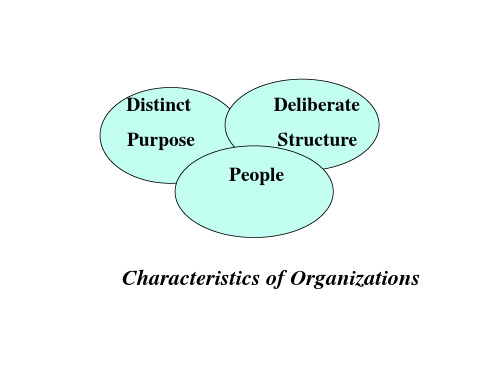
first-line
middle
managers managers
conceptual skills
top mangers
human skills
technical skills
Skills Needed at Different Management Levels
proficiently perform specific tasks.
human skills
The ability to work well with other people individually and in a group
conceptual skills
The ability to think and to conceptualize about abstract
work of the first-line managers.
top managers
Managers at or near the top level of the organization who are responsible for making
organization-wide decisions and establishing the goals and plans that affect the entire organization.
Management
Coordinating and overseeing the work activities of others so that their activities are completed
efficiently and effectively.
2011_罗宾斯_管理学_11版_英文PPT_04

Stereotyping
- judging a person based on a prejudicial perception of a group to which that person belongs. Discrimination - when someone acts out their prejudicial attitudes toward people who are the targets of their prejudice. Glass Ceiling - the invisible barrier that separates women and minorities from top management positions.
Bias
- a tendency or preference toward a particular perspective or ideology. Prejudice - a preconceived belief, opinion, or judgment toward a person or a group of people.
Age -
Both Title VII of the Civil Rights Act of 1964 and the Age Discrimination in Employment Act of 1967 prohibit age discrimination. Gender - Women (49.8%) and men (50.2%) now each make up almost half of the workforce.
Employee
Resource Groups - groups made up of employees connected by some common dimension of diversity.
管理学罗宾斯第11版
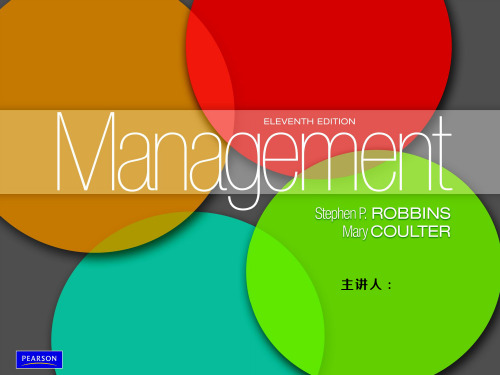
主讲人:
Copyright © 2012 Pearson Education, Inc.
Management, Eleventh Edition by Stephen P. Robbins & Mary CPouultberlishing as Prentice Hall
©2012 Pearson Education, Inc. All rights reserved
• Polycentric Attitude - the view that the managers in the host country know the best work approaches and practices for running their business.
• Geocentric Attitude - a world-oriented view that focuses on using the best approaches and people from around the globe.
Copyright © 2012 Pearson Education, Inc.
Management, Eleventh Edition by Stephen P. Robbins & Mary CPouultberlishing as Prentice Hall
©2012 Pearson Education, Inc. All rights reserved
3-9
Global Trade Mechanisms (cont.)
罗宾斯管理学第11版

《管理学》第11版罗宾斯Sail我是2014年参加的浙财会计学学硕考试,在考研的路上,也经过了许多波折坎坷,但总是告诉自己,前面就是光明。
时间在不断流逝,我们的心是否还依旧平稳,不管如何,希望大家一定要坚持下去,不要让自己后悔,有一段话,献给在考研路上努力奋斗着的童鞋们:贵在主动,重在过程,有心有序,有度有恒,求实求真,躬身力行。
我希望在你们挥汗奋斗的日子里,我能够带给你们一定的光明和正能量,相信自己,坚强地走下去。
加油!A Blueprint for AchievementPractice while others are complaining.Believe while others are doubting.Plan while others are playing.Study while others are sleeping.Decide while others are delaying.Prepare while others are daydreaming.Begin while others are procrastinating.Work while others are waiting.Save while others are wasting.Listen while others are talking.Smile while others are frowning.Compliment while others are criticizing.Persist while others are quitting.Progress while others are lagging behind.Then, you will succeed while others are failing.目录第一篇管理导论 2第1章管理与组织领导 21.1管理者为什么对组织很重要? 21.2谁是管理者以及他们在那里工作? 21.3管理者的职能、角色和技能。
管理学罗宾斯第11版11

管理学罗宾斯第11版11导言管理学罗宾斯第11版是一本非常经典的管理学教材,它通过深入浅出的方式讲解了管理学的核心概念和实践技巧,为读者提供了全面而精准的管理学知识。
在当今时代,管理学已经成为了一门举足轻重的学科,各行各业都需要管理学的知识来提高组织效率和个人绩效。
本文将分析管理学罗宾斯第11版的特点和优势,并探讨如何运用其中的理论和实践,帮助读者提升自己的管理能力和素质。
一、管理学罗宾斯第11版的特点和优势1. 严谨的理论体系管理学罗宾斯第11版的理论体系非常严谨和完备,覆盖了管理学的各个方面。
它系统地阐述了管理学的基本概念、管理过程、组织结构和行为、决策和问题解决、沟通和领导力等各个方面。
通过对这些理论的学习,读者可以建立起完整的管理体系,从而更好地应对实际问题和挑战。
2. 系统的案例分析管理学罗宾斯第11版涵盖了许多实际案例,这些案例基于真实的组织和管理场景,具有很强的现实意义和可操作性。
通过分析这些案例,读者可以更好地理解管理学理论的应用,同时也可以学习到一些成功管理者的经验和教训。
这些案例对于读者的实践能力和思维能力的培养具有重要意义。
3. 实用的工具和技巧管理学罗宾斯第11版赋予了读者很多实用的工具和技巧,这些工具和技巧可以帮助读者更好地管理组织和个人。
例如,它介绍了时间管理、沟通技巧、工作计划、团队建设、目标管理、决策分析等众多工具和技巧,这些内容不仅可以在工作中帮助读者提高效率和质量,也可以在生活中增强他们的管理素养和生产力。
4. 全面的更新和改进管理学罗宾斯第11版已经历了许多次更新和改进,每一版都保持了一定的稳定性和连续性,同时也增加了新的内容和知识点,涵盖了当今管理学研究的最新成果和发展趋势。
这种持续的更新和改进使得管理学罗宾斯第11版成为了一本永远活跃的管理学教材,具有很强的学习和参考价值。
二、如何运用管理学罗宾斯第11版的理论和实践1. 提高管理能力管理学罗宾斯第11版通过完备的理论体系和实用的工具和技巧,帮助读者全面提高管理能力。
管理学(斯蒂芬·P.罗宾斯)(11版中文)
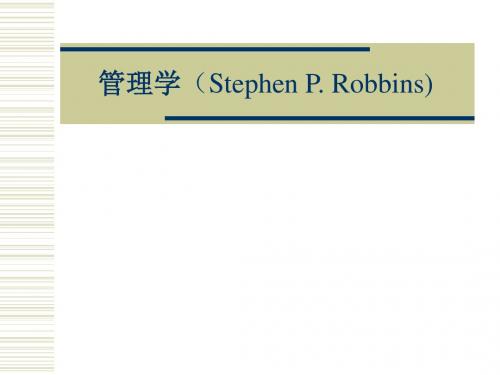
二、外部环境:约束和挑战
一般环境 具体环境 环境对管理者的影响
一般环境(1)
对所有组织都会产生影响; 组织在短时间内无法加以改变和影响而只 能适应和调整自己。 经济条件 政治/法律条件 社会文化条件 技术条件 自然条件
一般环境(2)
经济环境: 经济发展的阶段状况:萧条、停滞、 复苏、增长; 人均收入与购买力; 人口总数与市场潜力; 物价水平;基础设施;发展均衡性; 利率、汇率、投资率
管理实践活动的存在已经有了几千年的历史,而 管理理论的出现或者对管理的系统研究却是工业 革命以后的事情(1911年)。 劳动分工;合作成为必要 工业革命;机器代替人力 ——管理越来越重要,对管理的研究越来越 迫切,最终催生了现代管理学的出现。 (亚当· 斯密1776年的《国富论》对分工产生效 率有详细的论述。)
全球环境中的管理
谁是所有者 不同的全球观 理解全球环境 全球化经营 在全球环境中进行管理
谁是所有者
全球经济一体化 资源配臵、要素流动、产业链与分工、 竞争与合作 我们处在什么位臵? 我们与谁竞争?(谁是我们的敌人?谁是 我们的盟友?) 我们怎样管理?
一般环境(3)
政治/法律环境: 政治制度、体制; 政府的稳定性; 特殊的经济政策; 法律法规;
一般环境(4)
社会文化环境: 人口因素; 社会结构; 生活方式;工作态度;价值观; 道德风尚; 文化传统、教育;
一般环境(5)
技术环境: 技术发展 技术对产业的影响 技术对社会的影响
一般环境(6)
四、定量方法(管理科学理论)
数学和统计方法 全面质量管理
五、当代方法(管理理论)
过程方法 系统方法 权变方法
管理学罗宾斯第11版01
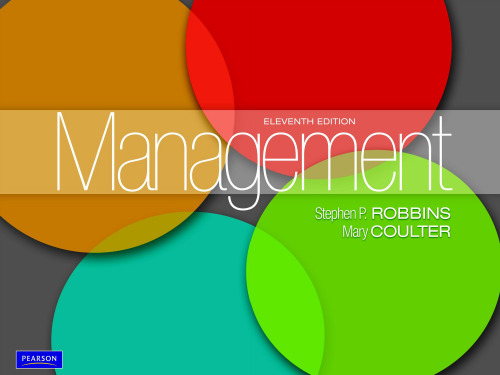
©2012 Pearson Education, Inc. publishing as Prentice Hall
1-7
Exhibit 1-2: Characteristics of Organizations
Management, Eleventh Edition by Stephen P. Robbins & Mary Coulter
Decisional roles
Entrepreneur, disturbance handler, resource allocator, negotiator
Management, Eleventh Edition by Stephen P. Robbins & Mary Coulter
©2012 Pearson Education, Inc. publishing as Prentice Hall
Common Characteristics of Organizations
Have a distinct purpose (goal) Are composed of people Have a deliberate structure
Management, Eleventh Edition by Stephen P. Robbins & Mary Coulter
Management, Eleventh Edition by Stephen P. Robbins & Mary Coulter
©2012 Pearson Education, Inc. publishing as Prentice Hall
1-3
Who Are Managers?
Manager
(完整版)管理学罗宾斯11版中英文对照详解
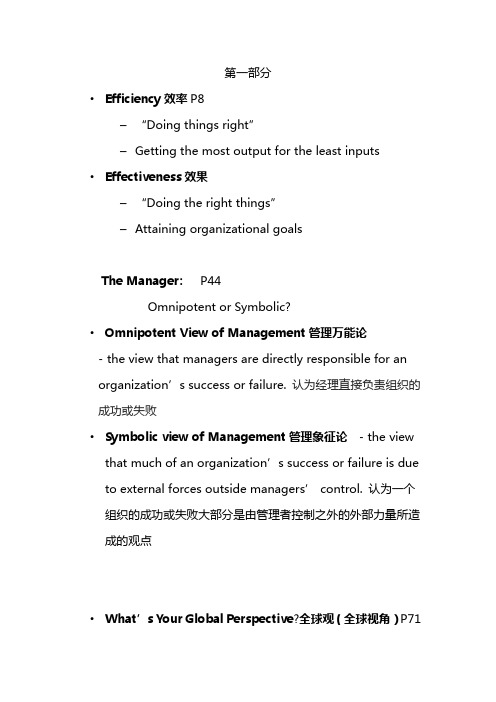
第一部分•Efficiency效率P8–“Doing things right”–Getting the most output for the least inputs •Effectiveness效果–“Doing the right things”–Attaining organizational goalsThe Manager: P44Omnipotent or Symbolic?•Omnipotent View of Management管理万能论- the view that managers are directly responsible for an organization’s success or failure.认为经理直接负责组织的成功或失败•Symbolic view of Management管理象征论- the view that much of an organization’s success or failure is due to external forces outside managers’ control.认为一个组织的成功或失败大部分是由管理者控制之外的外部力量所造成的观点•What’s Your Global Perspective?全球观(全球视角)P71•Parochialism狭隘主义- viewing the world solely through your own perspectives, leading to an inability to recognize differences between people.•Ethnocentric Attitude民族中心论- the parochialistic belief that the best work approaches and practices are those of the home country.本国取向•Polycentric Attitude多国论- the view that the managers in the host country know the best work approaches and practices for running their business.东道国取向•Geocentric Attitude全球中心论–a world-oriented view that focuses on using the best approaches and people from around the globe.全球取向•Multinational Corporation (MNC)跨国公司- a broad term that refers to any and all types of international companies that maintain operations in multiple countries. 任一或所有类型的在多国维持经营的国际性公司。
2011-罗宾斯-管理学-11版-英文PPT-09
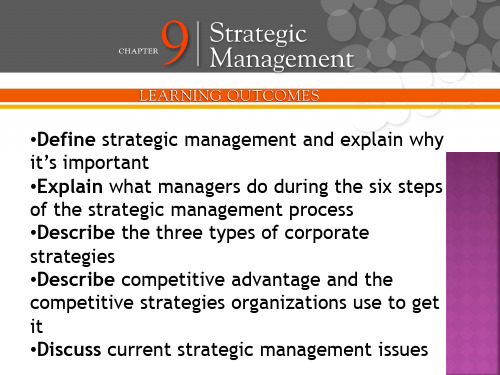
Step 6: Evaluating results
Analyzing financial and physical assets is fairly easy, but assessing intangible assets (employee skills, culture, corporate reputation, etc.) isn’t as simple.
Functional strategy - the strategies used by an organization’s various functional departments to support the competitive strategy.
Threat of New Entrants
Core competencies - the organization’s major value-creating capabilities that determine its competitive weapons.
Step 4: Formulating strategies
Develop and evaluate strategic alternatives.
Strategic management - what managers do to develop the organization’s strategies.
管理学罗宾斯11版中英文对照详解
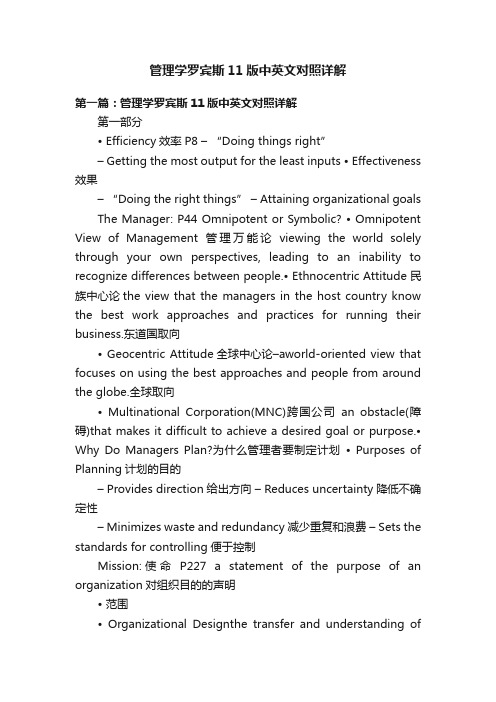
管理学罗宾斯11版中英文对照详解第一篇:管理学罗宾斯11版中英文对照详解第一部分• Efficiency效率P8 –“Doing things right”–Getting the most output for the least inputs • Effectiveness 效果–“Doing the right things” – Attaining organizational goals The Manager: P44 Omnipotent or Symbolic? • Omnipotent View of Management管理万能论viewing the world solely through your own perspectives, leading to an inability to recognize differences between people.• Ethnocentric Attitude民族中心论the view that the managers in the host country know the best work approaches and practices for running their business.东道国取向• Geocentric Attitude全球中心论–aworld-oriented view that focuses on using the best approaches and people from around the globe.全球取向• Mu ltinational Corporation(MNC)跨国公司an obstacle(障碍)that makes it difficult to achieve a desired goal or purpose.• Why Do Managers Plan?为什么管理者要制定计划• Purposes of Planning计划的目的– Provides direction给出方向– Reduces uncertainty降低不确定性– Minimizes waste and redundancy减少重复和浪费– Sets the standards for controlling便于控制Mission:使命P227 a statement of the purpose of an organization对组织目的的声明• 范围• Organizational Designthe transfer and understanding ofmeaning.意义的传递和理解• Transfer means the message was received in a form that ca n be interpreted by the receiver.• Understanding the message is not the same as the receiver agreeing with the message.• Interpersonal Communication人际沟通-communication between two or more people.主要指存在于两人或多人之间的沟通;• Organizational Communication组织沟通-all the patterns, networks, and systems ofcommunications within an organization.主要指组织中沟通的各种方式、网络Work specialization工作专门化Departmentalization部门化Chain of command指挥链Span of control管理跨度Centralization and decentralization集权与分权 Formalization 正规化和系统。
管理学罗宾斯第11版
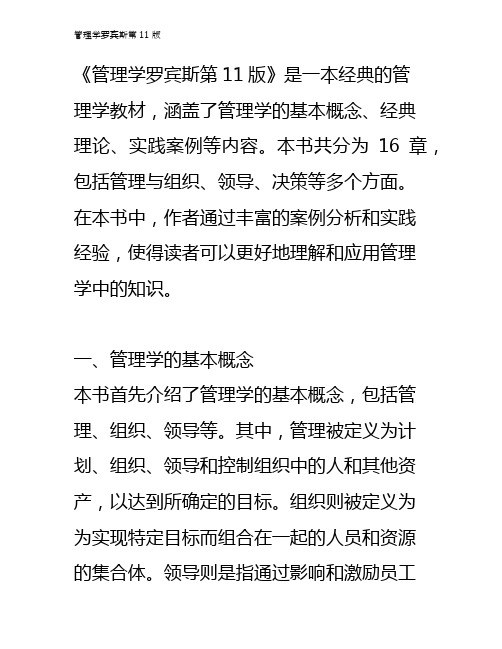
《管理学罗宾斯第11版》是一本经典的管理学教材,涵盖了管理学的基本概念、经典理论、实践案例等内容。
本书共分为16章,包括管理与组织、领导、决策等多个方面。
在本书中,作者通过丰富的案例分析和实践经验,使得读者可以更好地理解和应用管理学中的知识。
一、管理学的基本概念本书首先介绍了管理学的基本概念,包括管理、组织、领导等。
其中,管理被定义为计划、组织、领导和控制组织中的人和其他资产,以达到所确定的目标。
组织则被定义为为实现特定目标而组合在一起的人员和资源的集合体。
领导则是指通过影响和激励员工来达到组织目标的过程。
这些基本概念的理解是管理学学习的基石。
二、领导的重要性和类型领导在组织中起着至关重要的作用。
本书介绍了领导的概念、重要性以及各种类型的领导。
针对不同的组织环境和文化,领导的类型也不同。
本书主要介绍了传统领导、情境领导、认知领导等类型,并对这些类型的特点进行了详细介绍。
同时,作者还通过各种案例分析和实践经验,帮助读者更好地理解和应用领导理论。
三、企业决策企业决策是组织中最重要的任务之一。
本书涵盖了关于企业决策的多个主题,包括决策过程、决策者的行为和决策风险等。
在决策过程中,作者介绍了决策者所面临的各种选择和决策过程中的障碍。
同时,本书还强调了科学决策在企业中的重要性,包括运用数据分析和模型预测等方法。
四、人力资源管理人力资源是组织中最重要的资源之一。
本书涵盖了人力资源管理的多个方面,包括招聘、培训、绩效管理、员工关系等。
在这些方面,作者提供了许多实践经验和案例分析,帮助读者更好地理解和应用人力资源管理理论。
(完整版)管理书目清单

管理学/Management1.《管理学》(第11版):斯蒂芬·罗宾斯等,中国人民大学出版社,2012年2.《管理:使命、责任、实务》:德鲁克,机械工业出版社,2013年3.《公司的概念》:德鲁克,机械工业出版社,2009年4.《管理思想史》(第6版):雷恩、贝德安,中国人民大学出版社,2012年5.《认识商业》:威廉·尼科尔斯等,世界图书出版公司,2009年6.《管理百年》:斯图尔特·克雷纳,中国人民大学出版社,2013年7。
《管理经济学》:麦圭根等,机械工业出版社,2013年8.《看得见的手:美国企业的管理革命》:小艾尔弗雷德·钱德勒,商务印书馆,2014年9。
《管理的实践》:德鲁克,机械工业出版社,2009年10.《创新与企业家精神》:德鲁克,机械工业出版社,2009年11。
《经理人员的职能》:巴纳德,中国社会科学出版社,1997年12。
《管理行为》:西蒙,机械工业出版社,2013年13。
《管理大未来》:加里·哈默、比尔·布林,中信出版社,2008年战略/Strategy14。
《战略历程:纵览战略管理学派》:亨利·明茨伯格等,机械工业出版社,2002年15。
《战略管理思想史》:邹统钎、周三多,南开大学出版社,2011年16.《战略管理中国版》:希尔、琼斯、周长辉,中国市场出版社,2007年17.《创新者的窘境》:克莱顿·克里斯坦森,中信出版社,2014年18。
《孙子兵法》:孙武,中华书局,2011年19。
.《战略管理》:汤普森等,机械工业出版社,2011年20。
《公司战略:企业的资源与范围》:科利斯等,东北财经大学出版社,2005年21.《金融市场与公司战略》:MarkGrinblatt、Sheridan Titman,清华大学出版社,2003年22.《公司战略透视》:斯特恩等,上海远东出版社,1999年23。
- 1、下载文档前请自行甄别文档内容的完整性,平台不提供额外的编辑、内容补充、找答案等附加服务。
- 2、"仅部分预览"的文档,不可在线预览部分如存在完整性等问题,可反馈申请退款(可完整预览的文档不适用该条件!)。
- 3、如文档侵犯您的权益,请联系客服反馈,我们会尽快为您处理(人工客服工作时间:9:00-18:30)。
Strategic
Business Unit (SBU) - the single independent businesses of an organization that formulate their own competitive strategies. BCG matrix - a strategy tool that guides resource allocation decisions on the basis of market share and growth rate of SBUs.
Threat
Bargaining
to which buyers have the market strength to hold sway over and influence competitors in an industry
Bargaining
The ease or difficulty with which new competitors can enter an industry
The extent to which switching costs and brand loyalty affect the likelihood of customers adopting substitute products and services
Correct weaknesses and guard against threats.
Step
5: Implementing strategies
Implementation - effectively fitting organizational structure and activities to the environment. The environment dictates the chosen strategy; effective strategy implementation requires an organizational structure matched to its requirements.
1. 2.
It results in higher organizational performance. It requires that managers examine and adapt to business environment changes.
3.
It coordinates diverse organizational units, helping them focus on organizational goals.
Functional
strategy - the strategies used by an organization’s various functional departments to support the competitive strategy.
Threat
of New Entrants of Substitutes
Stability
strategy a corporate strategy in which an organization continues to do what it is currently doing. Renewal strategy a corporate strategy designed to address declining performance.
Step
2: Doing an external analysis
The environmental scanning of specific and general environments
Focuses on identifying opportunities and threats
Step
3: Doing an internal analysis
Assessing organizational resources, capabilities, and activities:
Strengths create value for the customer and strengthen the competitive position of the firm. Weaknesses can place the firm at a competitive disadvantage.
of Corporate Strategies
Growth: expansion into new products and markets.
Types
Stability: maintenance of the status quo.
Renewal: examination of organizational weaknesses that are leading to performance declines.
Steps 2 and 3 combined are called a SWOT analysis. (Strengths, Weaknesses, Opportunities, and Threats)
SWOT
analysis - an analysis of the organization’s strengths, weaknesses, opportunities, and threats. Resources - an organization’s assets that are used to develop, manufacture, and deliver a product to its customers. Capabilities - an organization’s skills and abilities in doing the work activities needed in its business.
Competitive
strategy - an organizational strategy for how an organization will compete in its business(es). Competitive advantage - what sets an organization apart; its distinctive edge.
Growth
strategy - a corporate strategy that’s used when an organization wants to expand the number of markets served or products offered, through either its current business(es) or new business(es).
Strategic
management process - a six-step process that encompasses strategic planning, implementation, and evaluation.
Step
1: Identifying the organization’s current mission, goals, and strategies
Step
6: Evaluating results
How effective have strategies been? What adjustments, if any, are necessary?
Corporate
strategy - an organizational strategy that determines what businesses a company is in or wants to be in, and what it wants to do with those businesses.
Mission: a statement of the purpose of an organization
The scope of its products and services
Goals: the foundation for further planning
Measurable performance targets
Strategic
management - what managers do to develop the organization’s strategies. Strategies - the plans for how the organization will do what it’s in business to do, how it will compete successfully, and how it will attract and satisfy its customers in order to achieve its goals. Business model - how a company is going to make money.
